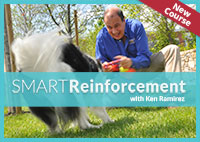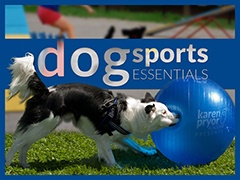Excerpted from Click for Joy: Questions and Answers from Clicker Trainers and their Dogs by Melissa Alexander, an unparalleled guide to the concepts of clicker training.

Q: How do I train my dog to lie down?
A: Various trainers have developed incredibly complex methods of compelling or luring a dog into lying down. However, the easiest way to teach a down is simply to capture it. Even the most frenetic dog will eventually settle and lie down. The trick is to make that behavior likely, so you have something to click and reinforce.
Getting the behavior
The best place to start capturing the down is in a bathroom—it's small and easy to clear of all potential distractions. Take your dog in, shut the door, and wait. Sit down and read a magazine. Ignore your dog. Eventually, she will lie down. The moment she settles, click and offer a treat.
As soon as you click, your dog will probably become very interested in you. She'll sit in front of you, stare holes in you, and try any and every behavior you've ever reinforced. Ignore her. Read your magazine. Eventually, she'll stop trying to entice you and lie down again. Click!
Do ten repetitions, then go play a game. Do another session later in the day or the next day. How long should you train in the bathroom? Keep doing bathroom sessions until the dog is actively offering downs to "make" you click. When you can get five downs in less than a minute you're probably ready to move to another room. It might take one session, or two, or ten.
Making it perfect
Getting the down is just the first step. Next add a cue, establish reliability in different locations, train for duration and/or distance, etc. As the trainer, it's up to you to figure out how and when you'll use the behavior and then to train for those occasions.
Again, no matter how you define down—or any other behavior—for your dog, keep the same progression in mind when you train:
- Get exactly the behavior you want.
- Add the cue.
- Make the behavior perfect by generalizing to different locations and adding elements such as duration, distance, and distractions.
- Make the behavior reliable by proofing everything you've taught in every situation you plan to use the behavior in.








i`m not very convinced that i
i`m not very convinced that i understand when we should start using a voice command ??? thank you
When + How to Add the cue
You'll add the cue when you're ready to bet me $50 that you know when the dog is going to do the behavior. For instance, if I'm teaching my dog to lie down, I would add the cue when it's very clear to me that the dog knows that laying down earns the click and treat. The dog is intentionally laying down to earn the click and treat. Once I can predict that the dog will lay down (I notice the movements the dog does right before he begins to down), I will then add the word.
So, let's say your dog is at that point: he's definitely aware that his laying down earns the click and treat and he's repeatedly laying down. As soon as your dog starts to lay down, you'd say your cue "lay," (or whatever word you want). Wait until the dog has completed the behavior, then click and treat as normal. The next time your dog starts to lay down, say "lay," and click and treat when the dog does.
UYou are simply telling the dog what he's already getting ready to do. You word isn't "making" him lay down. Your just pairing the word with the action. Does this make sense?
--
Laurie Luck
For Clickertraining.com
Karen Pryor Academy Certified Training Partner
See my profile and contact information at
http://karenpryoracademy.com/Luck_Laurie
6 year old dolmation dog
I hav a untrained 6 year old Dolmation dog and she is so hyper we cant let her run loose on our farm wat should i do
Hopeful
I have a 45 day old German Shepherd pup and he is extremely intelligent to say the least. Took me barely a week to teach him to sit, wait, come and talk to me on command. Its with the command "down" that i'm having massive problems. I've just ordered a few clickers and hope to get some positive results outta using one.
I generally place my palm behind his front paws when he is sitting and push him down gently. Once he's down he usually maintains that position for which I proceed to giving him a treat with "Good Down" and petting. But unless I physically follow this routine, all i get is a blank stare, wagging tail and barking every time I utter the word down.
I'm a beginner so hopefully I'll start afresh with the above technique and see what becomes of it :D
Great!
I have noticed when some people train with luring, it works, but they don't fade it fast enough and that's where the problem comes in. this is great for those people who are beginners and aren't sure when to fade lures.
problems with the floor
my dog knows to get down on command but the problem is that he will only do it on the carpet or other soft areas. what can i do? ive tried pushing little by little until he is 3/4 on the floor but still justs looks at me and only extends his 2 front paws.
floor problems response
what kind of dog do you have? its a possibility that its painful or uncomfortable for the dog to get down on a hard surface. I would make sure its not something medical before pushing it too much more. My teachers always say "make sure its not medical before thinking its behavioral. Just a thought. You never know. Maybe try moving your hands along his body to see if he flinches at any point. That would be a sign that hes painful.
Post new comment